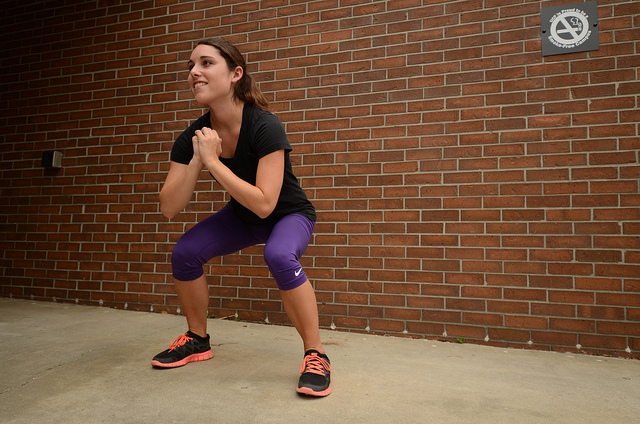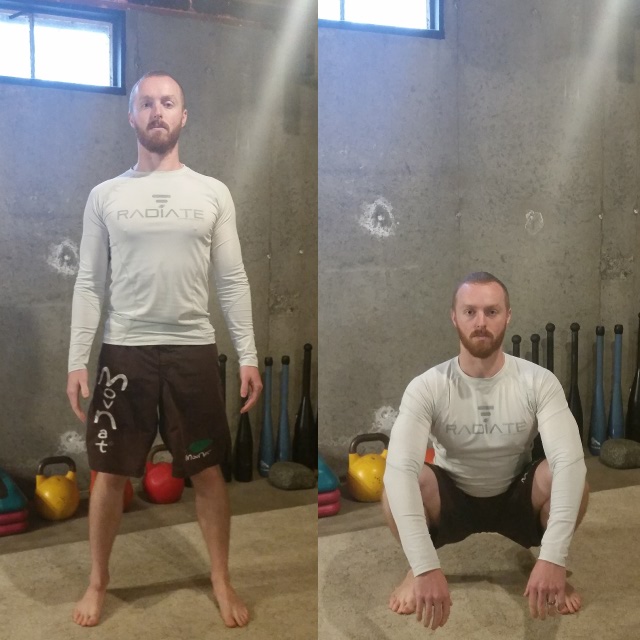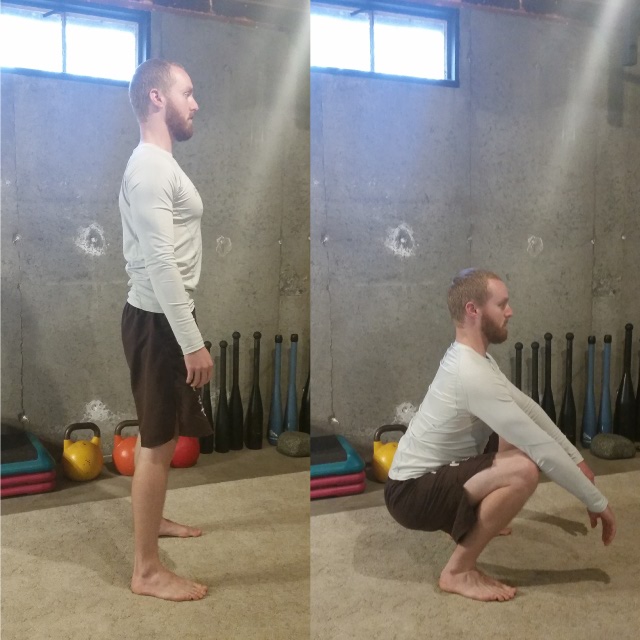
Most people can squat. But very few can squat properly. Even fewer can squat with excellent form. And it’s likely because most people are too tight or too weak in all the wrong places or they’ve just never learned how to squat correctly – period.
Even though the squat is a fairly simple movement pattern, it’s actually quite difficult for most people to accomplish a full range of motion, rock-bottom squat. And those who can are often out of alignment, uncomfortable, or worse.
Now, strength coaches, fitness professionals, old time strongmen, and weightlifters usually agree that squatting is the king of all strength exercises. And nobody would argue with the fact that it’s definitely way up there on the list.
Squatting is a natural human movement, and the bodyweight squat is perhaps the most fundamental calisthenics exercise there is. Everyone should be able to squat through a full range of motion effortlessly and without pain. And if you can’t, then this is a goal worth working towards that will pay off in both the short and long term.
Squatting serves many purposes, such as:
- a position for rest and recovery
- a movement reset
- a compensatory exercise pose
- a versatile tool for improving your strength, conditioning, mobility, and flexibility
Needless to say, if you’re a human, you would greatly benefit from learning, practicing, and training the squat exercise regularly. And the bodyweight squat (i.e. an unweighted squat, AKA “air squats”) is the first variation you should learn and master. In my opinion, you should not add additional load to a squatting movement (e.g. barbell, kettlebell, etc.) until you can perform at least 20 perfect bodyweight squats – and ideally, 50 or more reps with excellent technique.
So, in this detailed guide on proper squat form, you’ll learn both the basics of proper squat technique, and also many subtle nuances that will improve your performance (and your results!). This guide will go into a lot more depth than your typical textbook description or how-to video to help you maximize your results and minimize the risk of injury.
Proper Squat Form – At A Glance
Setup & Execution:
- Stand up straight with your feet at approximately shoulder-width apart.
- Keep your feet pointed either straight or angled slightly outward.
- Eyes should gaze forward or on the ground several feet in front of you.
- Initiate the movement with a fold at the hips by reaching your bum behind you, as if sitting in a chair.
- Maintain a mid-foot balance and a lengthened spine as you fold at the hips and bend at the knees – squatting between your legs, not on top of them.
- Keep your knees in line with your feet, being careful not to allow them to bow inward.
- Lower yourself as far as you can without losing balance, straining, or allowing your heels to rise off the ground.
- When you can squat no further (ideally, in the rock-bottom squat position with hamstrings resting on calves & bum just above the ground), pause for a moment.
- In the bottom position, your hips and knees should be fully flexed, your posture “tall” and feet flat on the ground. Arms can either be relaxed or reaching forward to help with balance.
- Some rounding of the lumbar spine in and near the bottom position is common and is usually safe when not under additional load.
- To get back up, reverse the motion by contracting your core, glutes, and thighs and driving your feet into the ground with a mid-foot balance while extending your hips until you are back in the standing position.
- Repeat for desired reps.


How to Perform Bodyweight Squats With Optimal Technique
Note: this is the bodyweight version of the squat exercise, which is the most basic variation that everyone should master regardless of training history or skill level. If you can’t perform a basic bodyweight squat with proper form, you should start with this variation before moving on to weighted squats and other variations.
Additional Technique Tips For The Bodyweight Squat Exercise
Foot Positioning – For most people, a hip to shoulder-width stance with feet either pointing straight ahead or slightly angled outward (i.e. 10-30 degrees) works best. However, there is no one-size-fits-all foot position that works for everyone. And some people may need a slightly different stance outside of this spectrum. So, in order to find the most efficient technique for you and your unique body type, you may have to do some experimenting.
The foot positioning that works best for you will have three qualities:
- Puts the least amount of strain on your joints, particularly your hips and knees. So, if you notice that one position results in excessive strain on one or more of your joints, try something else.
- Gives you the alignment you need to perform at your best (the position in which you feel the strongest, and most able to produce force). So, if you feel balanced, aligned, and able to lift a heavy weight, you’re on the right track. On the flip side, if you feel weak or wobbly, you should experiment with some other stances to see if things improve.
- Allows you to maintain a mid-foot balance throughout the full range of motion of the exercise (i.e. from standing to deep squatting).
So, wherever you feel the least amount of strain/tension/weakness/pain/etc. and the most amount of stability/control/strength/balance/etc. – that’s your ideal foot position.
Mid-Foot Balance – Your feet should be flat at all times when performing bodyweight squats, and you should maintain a mid-foot balance. That is, your body weight should be evenly distributed throughout the entire underside of your feet. So, do not allow your balance (i.e. your center of gravity) to come forward so that your weight transfers to your ball of foot and your heels begin to lift off the ground. Similarly, don’t allow too much of your weight to rest on your heels or instep. A mid-foot balance produces better alignment and a stronger squat.
Spinal Alignment – Ideally, your spine will remain in a neutral position throughout the full range of motion, but most people have difficulty achieving this. And for most people, it is okay to have some slight deviation from a neutral spine. So, do your best to maintain a lengthened spine (i.e. crown to coccyx alignment), at all times. More specifically, try to avoid arching the lower back when folding at the hips to squat down. Also, avoid rounding the upper back when in the bottom position (i.e. keep your posture “tall”). Please note that when in a deep, rock-bottom squat, some rounding of the lumbar spine is normal and is safe for most people*.
Regardless, try to make it a point to lengthen your spine in both directions – lifting with the crown of your head, and reaching with your tailbone in the opposite direction. With time and practice, this will become easier, and the process can be accelerated with specific mobility/flexibility exercises.
*assuming you have a healthy back (i.e. no pre-existing back injuries) and aren’t compressing your spine under additional load (e.g. barbell back squats).
Leg Drive & Knee Positioning – Resist the temptation to drive through the heel or forefoot exclusively. Instead, focus on driving the ground away from you by applying straight downward pressure throughout the entire underside of the feet. Your knees should track directly over the feet and remain in alignment with the ankle joint (i.e. stacked vertically – not bowing inwards or extending too far forwards) throughout the full range of motion.
Hip Recruitment – The hips and thighs power the squat exercise. So, to initiate the squat, fold or “hinge” at the hips while reaching your bum backwards, as if about to sit on the edge of a chair. This is a distinctly different movement from bending at the spine, which is not advised. Continue folding at the hips and bending at the knees, effectively squatting between your legs – not on top of your legs – until you have reached full hip flexion (or your deepest ROM). To squat back up, contract your glutes and thighs until you are back to the standing position with hips fully extended (i.e. not over-extended).
Core Activation – When squatting upward, activate your entire core musculature with a forceful contraction while also squeezing the glute and thigh muscles. This will provide a stable platform to protect your spine, and will assist in the power generation of the exercise. Your exhale should be timed with this contraction (see below).
Shoulders and Arms – The arms and shoulders can be used in two ways:
a) Shoulders relaxed and resting comfortably on torso and arms relaxed either at your sides or in front of you.
b) Shoulders “packed” (i.e. slightly retracted and stabilized down on torso), and arms reaching forward to assist with balance – with elbows bent or straight.
Breathing – There are two primary breathing techniques that are most applicable to body weight squats:
a) Discipline Breathing – Exhaling on effort during the concentric portion of the exercise (i.e. standing back up), and inhaling when squatting down. This is the standard strength and conditioning breathing technique and is what most people should use. Focus on exhaling forcefully through the mouth in combination with a strong core contraction. Inhale passively when squatting back down.
b) Flow Breathing – Exhaling on compression of the lungs (i.e. when squatting down), and inhaling on expansion of the lungs (i.e. when standing up). You’ll note that this is the exact opposite breathing pattern as the former. Some advanced trainees may want to experiment with this technique, which is a more efficient breathing pattern (note: but not necessarily the best for strength and power generation).
Range of Motion – Descend as deeply as your range of motion allows until either a) your form breaks down, or b) your hips and knees are fully flexed with hamstrings resting on your calves and bum just above the ground (note: this is the rock-bottom squat position). For most people, this squat depth is difficult to achieve without regular practice. Squat back up until standing upright again, hips in line with your shoulders, knees directly beneath your hips, and with a mid-foot balance. In the top, standing position, your hips are extended (not hyper-extended) and knees are straight, but not locked.
Common Mistakes
- Not squatting deep enough (i.e. only using a partial range of motion)
- Squatting too fast (i.e. not smoothly, under control)
- Allowing the knees to bow inwards
- Allowing the knees to travel too far forwards (e.g. ahead of toes)
- Letting the heels come off the ground, or losing mid-foot balance, in general
- Excessive rounding of the spine (i.e. not maintaining a lengthened spine and an upright torso)
- Excessive arching of the lower back
Final Words
The squat is such a fundamental natural human movement skill, and it’s well-worth the effort to master this critical exercise. My advice is to get the technique right from the start. Training smart always pays off in the long run. And a strong bodyweight squat will set a great foundation for your training down the road.
More Information
- How to Increase Your Squat Depth (version 1.0)
- Jump Squats How-To
- Max Set of Bodyweight Squats
- Single-Leg Squats Progression
- Bodyweight Training for Functional Leg Strength
If you found this article helpful, please share it with your friends and tweeps:
.jpg)
![]()
Health-First Fitness Coach
P.S. If you liked this post, then please signup for the newsletter, or follow me on Facebook or Twitter for daily updates and other interesting info.
Photo credit: 1.
Hey John, thanks for all your info. I always feel a huge difference between doing bodyweight squats with shoes on and doing squat barefoot, a can go deeper when I have my shoes on, I just wanted to know if it something “normal”, have you ever heard other people talking about that difference?
Hi Alkol, It’s totally normal and very common. The reason is likely because your shoes have elevated heels, which will decrease the ankle flexion required when squatting. It’s the same reason why some people are able to squat more deeply with their heels slightly elevated (e.g. by placing a small, flat board beneath their heels), which is a common quick-fix for people who have trouble squatting because of poor ankle mobility and/or calf flexibility.
thanks a lot